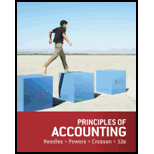
Principles of Accounting
12th Edition
ISBN: 9781133626985
Author: Belverd E. Needles, Marian Powers, Susan V. Crosson
Publisher: Cengage Learning
expand_more
expand_more
format_list_bulleted
Concept explainers
Textbook Question
Chapter 5, Problem 3EA
The lettered items that follow represent a classification scheme for a
- a. Current liabilities
- b. Owner’s equity
- c. Current assets
- d. Intangible assets
- e. Property, plant, and equipment
- f. Investments
- g. Long-term liabilities
- h. Not on balance sheet
- 1. Patent
- 2. Building Held for Sale
- 3. Prepaid Rent
- 4. Wages Payable
- 5. Note Payable in Five Years
- 6. Building Used in Operations
- 7. Fund Held to Pay Off Long-Term Debt
- 8. Inventory
- 9. Prepaid Insurance
- 10.
Depreciation Expense - 11.
Accounts Receivable - 12. Interest Expense
- 13. Unearned Revenue
- 14. Short-Term Investments
- 15.
Accumulated Depreciation - 16. Owner’s Capital
Expert Solution & Answer
Want to see the full answer?
Check out a sample textbook solution
Students have asked these similar questions
general accounting
During 2022, Crystal Resort reported revenue of $45,000. Total expenses for the year were $29,000. Crystal Resort ended the year with total assets of $34,000, and it owed debts totaling $12,500. At year-end 2021, the business reported total assets of $28,600 and total liabilities of $11,000. A. Compute Crystal Resort's net income for 2022. B. Did Crystal Resort's stockholders' equity increase or decrease during 2022? By how much?
What is gamma's direct labor price variance ?
Chapter 5 Solutions
Principles of Accounting
Ch. 5 - Prob. 1DQCh. 5 - Prob. 2DQCh. 5 - Prob. 3DQCh. 5 - Prob. 4DQCh. 5 - Prob. 5DQCh. 5 - Prob. 6DQCh. 5 - Prob. 7DQCh. 5 - Prob. 1SECh. 5 - Prob. 2SECh. 5 - Tell whether each of the following accounts is a...
Ch. 5 - Prob. 4SECh. 5 - Prob. 5SECh. 5 - Prob. 6SECh. 5 - Prob. 7SECh. 5 - The lettered items that follow represent a...Ch. 5 - Each of the statements that follow violates one or...Ch. 5 - The lettered items that follow represent a...Ch. 5 - Prob. 4EACh. 5 - Prob. 5EACh. 5 - Prob. 6EACh. 5 - Prob. 7EACh. 5 - Prob. 8EACh. 5 - Prob. 1PCh. 5 - The information that follows is from Jasons...Ch. 5 - Prob. 3PCh. 5 - Prob. 4PCh. 5 - Prob. 5APCh. 5 - The information that follows is from Matts...Ch. 5 - Prob. 7APCh. 5 - The information that follows is from Rodriguezs...Ch. 5 - Prob. 1CCh. 5 - Prob. 2CCh. 5 - Prob. 3CCh. 5 - Prob. 4CCh. 5 - Prob. 5C
Knowledge Booster
Learn more about
Need a deep-dive on the concept behind this application? Look no further. Learn more about this topic, accounting and related others by exploring similar questions and additional content below.Similar questions
- Financial Accountingarrow_forwardWhat is the operating cycle?arrow_forwardHalle Manufacturing has an overhead application rate of 125% and allocates overhead based on direct materials. During the current period, direct labor is $78,000, and direct materials used are $112,000. Determine the amount of overhead Halle Manufacturing should record in the current period. a. $78,000 b. $97,500 c. $112,000 d. $140,000 e. $190,000 help.arrow_forward
arrow_back_ios
SEE MORE QUESTIONS
arrow_forward_ios
Recommended textbooks for you
 College Accounting (Book Only): A Career ApproachAccountingISBN:9781337280570Author:Scott, Cathy J.Publisher:South-Western College Pub
College Accounting (Book Only): A Career ApproachAccountingISBN:9781337280570Author:Scott, Cathy J.Publisher:South-Western College Pub College Accounting, Chapters 1-27AccountingISBN:9781337794756Author:HEINTZ, James A.Publisher:Cengage Learning,
College Accounting, Chapters 1-27AccountingISBN:9781337794756Author:HEINTZ, James A.Publisher:Cengage Learning, Cornerstones of Financial AccountingAccountingISBN:9781337690881Author:Jay Rich, Jeff JonesPublisher:Cengage Learning
Cornerstones of Financial AccountingAccountingISBN:9781337690881Author:Jay Rich, Jeff JonesPublisher:Cengage Learning Financial And Managerial AccountingAccountingISBN:9781337902663Author:WARREN, Carl S.Publisher:Cengage Learning,
Financial And Managerial AccountingAccountingISBN:9781337902663Author:WARREN, Carl S.Publisher:Cengage Learning,

College Accounting (Book Only): A Career Approach
Accounting
ISBN:9781337280570
Author:Scott, Cathy J.
Publisher:South-Western College Pub

College Accounting, Chapters 1-27
Accounting
ISBN:9781337794756
Author:HEINTZ, James A.
Publisher:Cengage Learning,

Cornerstones of Financial Accounting
Accounting
ISBN:9781337690881
Author:Jay Rich, Jeff Jones
Publisher:Cengage Learning

Financial And Managerial Accounting
Accounting
ISBN:9781337902663
Author:WARREN, Carl S.
Publisher:Cengage Learning,
ACCOUNTING BASICS: Debits and Credits Explained; Author: Accounting Stuff;https://www.youtube.com/watch?v=VhwZ9t2b3Zk;License: Standard Youtube License